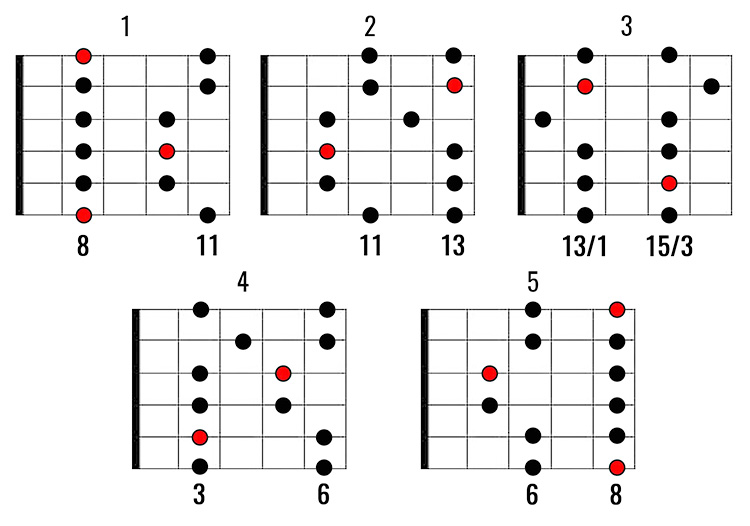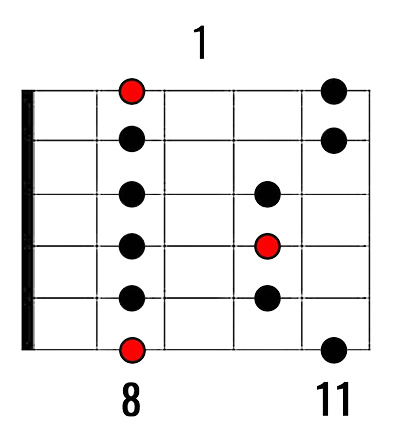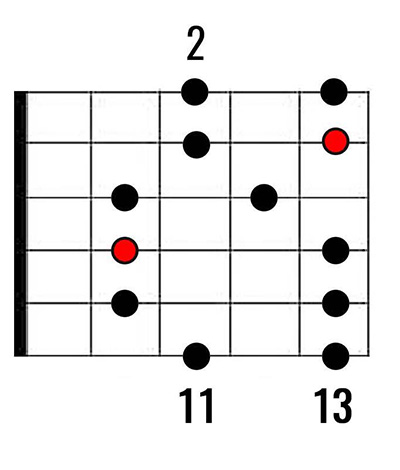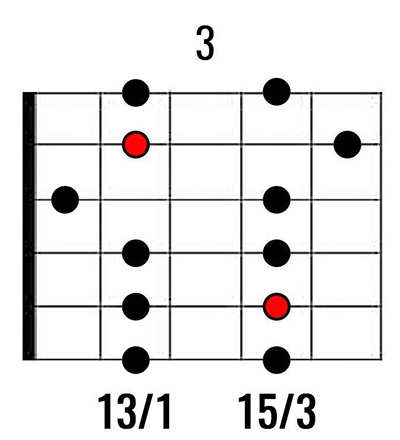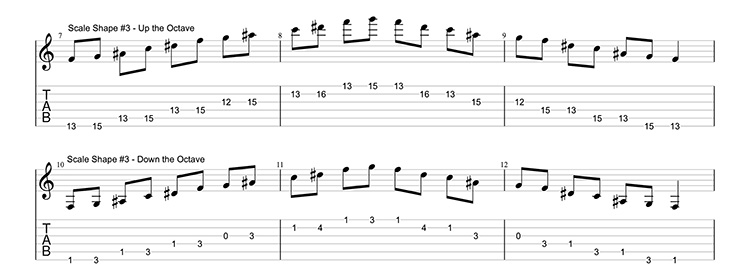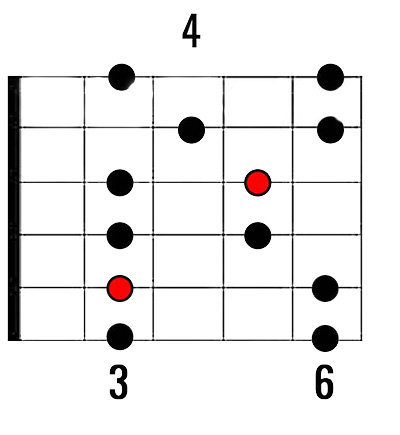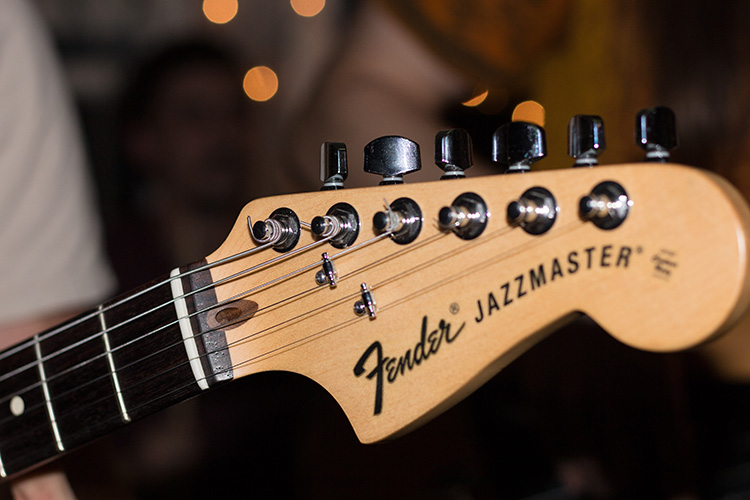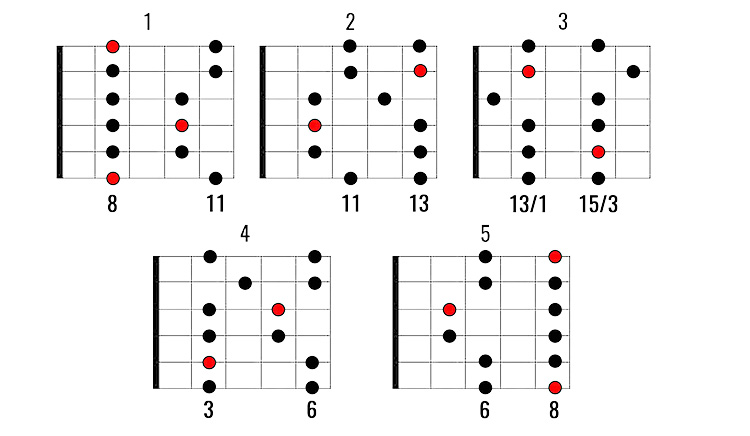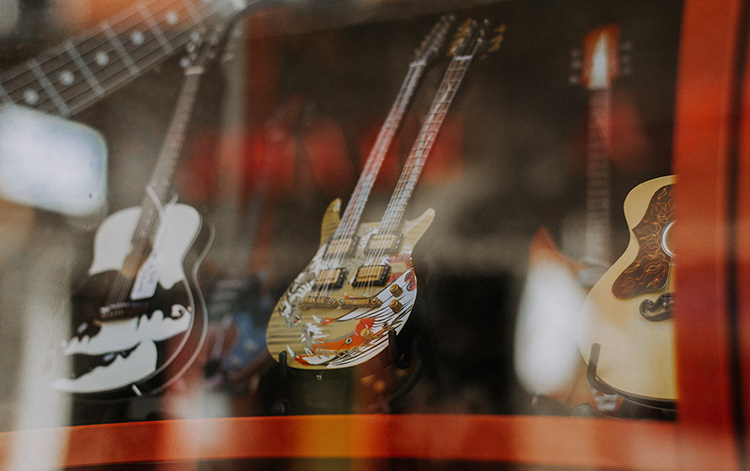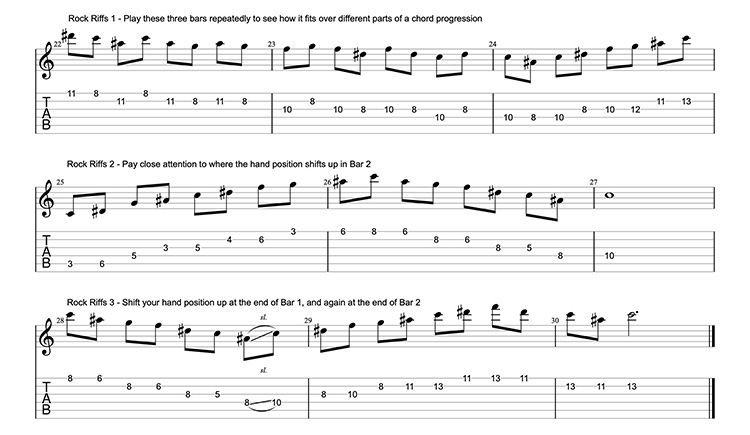The C minor pentatonic scale is a scale that EVERY type of guitarist must-know. In this lesson we’ll show you everything you need to know about this cool guitar scale.
Over 250,000 guitar-learners get our world-class guitar tips & tutorials sent straight to their inbox: Click here to join them
In this free lesson you will learn:
- 6 essential ways to play the C minor pentatonic scale
- 3 quick & easy lead guitar hacks that will turbo-charge your solos
- 5 must-know guitar secrets for intermediate guitarists
What is a Pentatonic Scale?
The pentatonic scale is a five-note scale that can be used for a variety of different melodic purposes.
- This is an extremely popular scale across many genres of music.
- The pentatonic scale originates from the diatonic scale (7 notes), and has two fewer notes than its parent scale.
- The C minor pentatonic scale can be broken down into ‘boxes’ that we can play in, and each box is composed of the same notes played in a different order.
The five notes of the C minor pentatonic scale can provide us with a world of melodic possibilities!
The Five Boxes of The C Minor Pentatonic Scale
- The C minor pentatonic scale (and all others like it) is divided into five boxes. We call the first box the root position.
- Each one of these box shapes begins on a different note of the C minor pentatonic scale.
Deconstructing the scale this way gives us a better look into where we can play across the fretboard. It’s important to learn each of these boxes first before attacking the whole fretboard.
Each of the following positions will be slightly different than the last, but remember that all of the notes are the same throughout.
Each position after the root position begins on a different note of the scale.
For example:
- The root position begins on the 8th fret and starts with the 1st note of the scale. (C).
- The second position begins on the 11th fret and starts with the 2nd note of the scale. (Eb).
- The third position begins on the 13th/1st fret and starts with the 3nd note of the scale. (F).
- The fourth position begins on the 3rd fret and starts with the 4th note of the scale. (G).
- The fifth position begins on the 6th fret and starts with the 5th note of the scale. (Bb).
Skill Tip: Always remember when practicing to stretch first before you play. This ensures that we are minimizing the risk of straining our hands when playing. Safety first!
Download our lead guitar cheat-sheet to make things easier
It's hard to understand which scales work with which keys.
So we created a cheat-sheet! A key and scale-finder that you can use again and again.

Get your personalised guitar-learning plan 🎸
Get a custom guitar-learning plan here: Click here for GuitarMetrics™
World-Class Guitar Courses 🌎
Learn from the world's best guitar educators: Click here for our guitar courses
C Minor Pentatonic Scale – Root Position (C)
The first box shape of this scale begins on the 8th fret of the guitar.
- We should always lead with our index finger when playing the root position of any minor pentatonic scale.
- This leaves our ring and pinky available for the notes ahead.
We won’t be using our middle finger for this scale shape, but we can position our other three fingers like so:
8th fret – Index finger.
10th fret – Ring finger.
11th fret – Pinky finger.
Most common scale shapes occur in four fret boxes, which is convenient for our hands.
Using the pinky finger when we’re first starting out can be tricky.
- In terms of the human hand, the pinky is the one finger that doesn’t really have a dedicated use.
- For example, you hold your pen with your thumb and index finger.
You type with your index and middle. What do you do with your pinky?
(Answer: You play guitar!)
The pinky will naturally have less strength than your other fingers. Take the time to give it the practice that it needs and you’ll be shredding the C minor pentatonic scale in no time.
Skill Tip: Focusing on alternate picking when playing these scale shapes keeps the picking hand strong.
C Minor Pentatonic Scale – Box Shape #2 (Eb)
The second shape of this scale makes for great practice in finger independence.
- Begin with your middle finger on the 11th fret and follow with the pinky finger on the 13th.
- We start this shape in this way because we need to step back to the 10th fret when we reach the A string.
This shape will utilize all of our fingers, so make sure each one has its own assigned fret.
Take a look at the scale shape below:
C Minor Pentatonic Scale – Box Shape #3 (F)
As we discussed earlier, some scale shapes require five frets to play.
- With only four fingers, this can appear difficult at first – but fret not!
- Like shape #2 of the C minor pentatonic scale, we can begin with our middle finger, this time on the 13th fret.
- If your guitar only has access to twelve frets, you can start this scale on your first fret as well.
The move back to the 12th fret can be played with an open G string instead.
Playing in this position is called “playing down the octave.”
If we are playing at the 13th fret, we can use our index finger to make the step to the 12th on the G.
- When we reach the B string, we can use our index finger to step back up to the 13th fret, as we will need our pinky to reach the 16th (or 4th) fret.
- Making these stretches when practicing helps keep our hand and fingers limber, which in turn helps us play better.
Skill Tip: For the beginner guitarist, you might experience some discomfort at first when playing this scale shape, so don’t be afraid to take frequent breaks!
Get up, stretch, go for a run and come back to it. Your hands will thank you for giving them time to adjust.
C Minor Pentatonic Scale – Box Shape #4 (G)
Our fourth shape will take us down the fretboard to the 3rd fret.
- By this point, we’ve already reached the 16th fret in shape #3, so it’s time to relocate.
- This shape loosely resembles scale shape #1, so we can play it starting from the index finger.
- In this shape of the C minor pentatonic scale, we will need our middle finger to play the 5th fret on the B string.
This shape is once again a great practice in finger independence, so make sure you play it slowly the first time through.
Remember when playing these shapes of the C minor pentatonic scale that we are only ever playing the same five notes.
The order of these notes changes with each scale shape, but no new notes are added past the five we are playing now.
Skill Tip: Listen carefully when playing each scale shape. Each one has its own unique tone that is useful over different chords in the C minor pentatonic scale.
Try playing each of these scale shapes over this slow blues chord progression here. Take note of how each note interacts with the chords underneath it, and decide what sounds you like best.
C Minor Pentatonic Scale – When to Use It
The C minor pentatonic scale can be used across a variety of genres.
- This scale is favoured by many blues, rock, jazz and pop musicians.
The notes of the C minor pentatonic scale are as follows:
C – Eb – F – G – Bb – C
The chords in the key of C minor itself are:
- C minor
- D diminished
- Eb major
- F minor
- G minor
- Ab major
- Bb major
Combine any of these chords in a progression and you’ll have something that you can play the C minor pentatonic scale over.
C minor creates a moody and (sometimes) very bluesy feeling.
Classic songs like Bon Jovi’s “You Give Love A Bad Name” are written in this key for that reason.
For those of us that love a good guitar solo (who doesn’t, really?), C minor pentatonic fits well over a variety of keys that share the same notes.
C minor, Eb major and C major are just a few examples of keys that we can play this scale over.
Skill Tip: As important as it is to know the notes of the scale you’re soloing in, knowing the chord changes in a song will always give you a better foundation to play over.
Don’t forget to always listen first.
C Minor Pentatonic Scale – Box Shape #5 (Bb)
Our fifth and final scale shape takes place from the 5th fret to the 8th, and we begin on the 6th with our middle finger.
- Similar to shape #2 but without the ring finger, this shape gives our middle finger a chance to flex its muscles.
- Once again, we leave the index finger open to handle the work on the 5th fret, and our pinky for the 8th.
- This shape is a stretch, but can help to develop finger strength quickly if practiced enough.
Take a look at the shape below:
Now that we have reached the last scale shape, you will notice that the last note of this shape (on the high E string) is a C.
Congratulations, you’ve successfully played all five shapes of the C minor pentatonic scale!
Skill Tip: Practice all of these shapes in ascending and descending order in order to get to know them better. Playing scales up and down helps us remember not only the positions, but the notes as well.
In the next section, we’re going to put it all together.
Connecting The Shapes of the C Minor Pentatonic Scale
Look how far you’ve come! Make sure you take a breather before we move on.
- Learning all five scale shapes is one part of the C minor pentatonic scale.
- The other is combining them to give ourselves a complete map of the fretboard.
The best way to practice this is with all of the scale shapes in front of us, so don’t forget to grab the downloadable PDF of this lesson so you have a good reference.
Let’s look at an example that will help us string together shapes 1, 2 and 5.
It’s important to look at the space that is shared between scale shapes, as it helps us understand how they are all linked.
Effective practice of scales can help us create a seamless ‘mental map’ of the fretboard.
- This is crucial for every guitarist in order to understand what and where they are playing.
- For example, you may have noticed that the root position shares the 10th and 11th frets with scale shape #2.
- Scale shape #2 also shares the 12th and 13th frets with shape #3, and so on.
Take the time to practice and pay attention to all of the fine details – it’s worth it!
Learn 12 EASY beginner chords with our popular guide

✅ Stop struggling. Start making music.
✅ Learn beginner-friendly versions of every chord.
This is our most popular guide and it will improve your chord ability quickly! 😎
Get your own personalised guitar-learning plan 🎸
Get a custom guitar-learning plan here: Click here for GuitarMetrics™
World-Class Guitar Courses 🌎
Learn from the world's best guitar educators: Click here for our guitar courses
C Minor Pentatonic Scale Rock Licks
Challenge Time! We can’t let you walk away from this lesson without a few cool licks to play over the next backing track you find, so we’ve drawn some up here for you to play.
These may look difficult, but they really aren’t.
Skill Tip: As always, practicing bar-to-bar is crucial as it helps us understand the ‘bigger picture’ of what we’re playing.
Don’t be afraid to break things down and play slowly!
Focus on alternate picking in these examples, as it helps to develop fluid motion in your picking hand. Alternate picking also helps us get from one string to the next a lot easier, so it’s a technique that’s worth practicing and developing.
Skill Tip: These examples work well over a variety of C minor chord progressions, so keep them in your riff library.
As we progress as musicians, it’s important to keep a short list of licks that we like and that work well in musical situations.
Jazz musicians have done this for years, as a result of this jazz licks have been reused and recycled throughout popular music.
Check out Adam Neely’s video on YouTube where he talks about “The Lick” (skip to 1:25).
Power Tip: If you’re the type of musician that enjoys learning about music theory, Adam Neely is a great YouTuber to watch. He provides insight into a variety of musical topics related to theory, culture and Jazz music. Check him out!
Where do I go from here?
Not finished with your daily practice and want more? We recommend:
- Pick up a copy of the Guitar Scales Handbook.
- Find new jam tracks to practice over on YouTube (Check out Quist).
- Say the name of every note as you play it to memorize them all.
- Listen to more songs in the key of C Minor.
- Watch this video from Mangold Project about why Pentatonic Melodies work so well.
Recommended Resources
If you’re looking for more free lessons, we’ve got plenty in stock! Check out a few of our relevant favourites below:
- Alternate Picking: The Ultimate Guide
- 10 Guitar Tips I Wish Someone Had Taught Me
- 10 Easy Songs on Guitar
- Learn Guitar Scales in 8 Easy Steps
- What’s the Difference Between Sharps & Flats?
What Type of Guitarist Are You?
Take our 60-second quiz & get your results: Take The Quiz
Join the world's best online guitar school 🌎
- Get your own personalised guitar learning plan (customised just for YOU).
- World-class online guitar courses. Learn at your own pace.
- Community Campus & Learning Forum - A friendly community! Connect with our team & students. 😊
- Beginner Song library with chordsheets, tabs and tips. (Songs suitable for all levels!)
- Regular live streams, seminars and Q&A sessions - Learn from world-class guitar educators. Get all your questions answered!
Click here to learn more about National Guitar Academy membership 
Cool Guitar T-shirts 😎
Look cooler! Check out our merch: Click here to see our merch store
Want free guitar tips and video lessons delivered to your inbox?
Join over 250,000 other guitar learners and subscribe to our guitar-tips-by-email service. (It's free.)
We'll send you a series of lessons that will move you to the next level of your guitar journey.
Learn how everything fits together quickly, easily and effectively. We share ninja tips (for instant fun!) but also timeless fundamentals that will deepen your understanding.

Popular Lessons
How To Learn Guitar: An 11-Step Programme For Beginners
How To Choose The Perfect Beginner Guitar
More Cool Guitar Stuff
Learn about National Guitar Academy: About Us
Visit our YouTube channel for fun guitar videos.
Join us on Facebook for daily guitar tips.
Listen to our Learn Guitar Podcast for rapid guitar progress.
Check out our free chord lessons.
Get our best guitar tips & videos
Where should we send it?
Where should we send it?
Get our best guitar tips & videos


